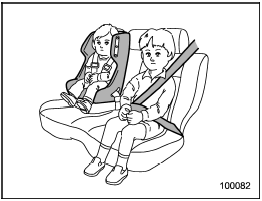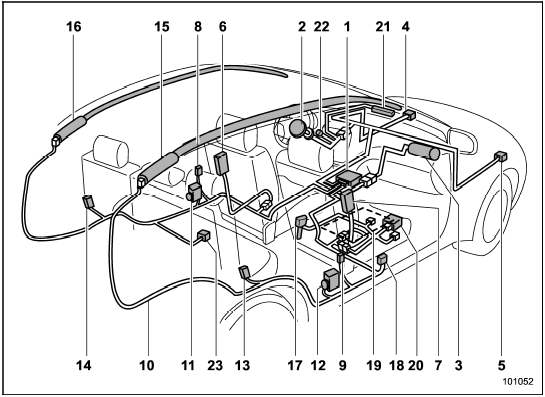Models with SRS airbags and lap/shoulder restraints for driver, front passenger, and window-side rear passengers
Your vehicle is equipped with a supplemental restraint system in addition to a lap/shoulder belt at each front seating position and each rear window-side seating positions. The supplemental restraint system (SRS) consists of six airbags.
The configurations are as follows.
- Driver’s and front passenger’s frontal
airbags
- Driver’s and front passenger’s side
airbags
- Curtain airbags (for driver, front passenger,
and window-side rear passengers)
These SRS airbags are designed only as a supplement to the primary protection provided by the seatbelt.
The system also controls front seatbelt pretensioners. For operation instructions and precautions concerning the seatbelt pretensioner, refer to “Front seatbelt pretensioners”.

- To obtain maximum protection in the event of an accident, the driver and all passengers in the vehicle should always wear seatbelts when the vehicle is moving.
The SRS airbag is designed only as a supplement to the primary protection provided by the seatbelt.
It does not do away with the need to fasten seatbelts. In combination with the seatbelts, it offers the best combined protection in case of a serious accident.
Not wearing a seatbelt increases the chance of severe injury or death in a crash even when the vehicle has the SRS airbag.
For instructions and precautions concerning the seatbelt system, refer to “Seatbelts”.
- Do not sit or lean unnecessarily close to the SRS airbag. Because the SRS airbag deploys with considerable speed – faster than the blink of an eye – and force to protect in high speed collisions, the force of an airbag can injure an occupant whose body is too close to SRS airbag.
It is also important to wear your seatbelt to help avoid injuries that can result when the SRS airbag contacts an occupant not in proper position such as one thrown forward during pre-accident braking.
Even when properly positioned, there remains a possibility that an occupant may suffer minor injury such as abrasions and bruises to the face or arms because of the SRS airbag deployment force.
- The SRS airbags deploy with considerable speed and force.
Occupants who are out of proper position when the SRS airbag deploys could suffer very serious injuries. Because the SRS airbag needs enough space for deployment, the driver should always sit upright and well back in the seat as far from the steering wheel as practical while still maintaining full vehicle control and the front passenger should move the seat as far back as possible and sit upright and well back in the seat.
- Do not place any objects over or near the SRS airbag cover or between you and the SRS airbag.
If the SRS airbag deploys, those objects could interfere with its proper operation and could be propelled inside the vehicle and cause injury.


- Put children aged 12 and under in the rear seat properly restrained at all times. The SRS airbag deploys with considerable speed and force and can injure or even kill children, especially if they are 12 years of age and under and are not restrained or improperly restrained. Because children are lighter and weaker than adults, their risk of being injured from deployment is greater.
For that reason, we strongly recommend that ALL children (including those in child seats and those that have outgrown child restraint devices) sit in the REAR seat properly restrained at all times in a child restraint device or in a seatbelt, whichever is appropriate for the child’s age, height and weight.
Secure ALL types of child restraint devices (including forward facing child seats) in the REAR seats at all times.
According to accident statistics, children are safer when properly restrained in the rear seating positions than in the front seating positions.
For instructions and precautions concerning the child restraint system, refer to “Child restraint systems”.
- NEVER INSTALL A REARWARD FACING CHILD SEAT IN THE FRONT SEAT. DOING SO RISKS SERIOUS INJURY OR DEATH TO THE CHILD BY PLACING THE CHILD’S HEAD TOO CLOSE TO THE SRS AIRBAG.
- Never allow a child to stand up, or to kneel on the front passenger’s seat, or never hold a child on your lap or in your arms. The SRS airbag deploys with considerable force and can injure or even kill the child.

- When the SRS airbag deploys, some smoke will be released.
This smoke could cause breathing problems for people with a history of asthma or other breathing trouble. If you or your passengers have breathing problems after SRS airbag deploys, get fresh air promptly.
- A deploying SRS airbag releases hot gas. Occupants could get burned if they come into direct contact with the hot gas.
NOTE
When you sell your vehicle, we urge
you to explain to the buyer that it is
equipped with SRS airbags by alerting
the buyer to the applicable section in
this Owner’s Manual.

Components
1) Airbag control module (including impact and rollover sensors)
2) Frontal airbag module (driver’s side)
3) Frontal airbag module (front passenger’s side)
4) Front sub sensor (left-hand side)
5) Front sub sensor (right-hand side)
6) Side airbag module (driver’s side)
7) Side airbag module (front passenger’s side)
8) Side airbag sensor (center pillar left-hand side)
9) Side airbag sensor (center pillar righthand side)
10) Airbag wiring
11) Seatbelt pretensioner (driver’s side)
12) Seatbelt pretensioner (front passenger’s side)
13) Curtain airbag sensor (rear wheel house right-hand side)
14) Curtain airbag sensor (rear wheel house left-hand side)
15) Curtain airbag module (right side)
16) Curtain airbag module (left side)
17) Seatbelt buckle switch (front passenger’s side)
18) Front passenger’s seatbelt tension sensor
19) Front passenger’s occupant detection system weight sensor
20) Front passenger’s occupant detection control module
21) Front passenger’s frontal airbag ON and OFF indicator
22) SRS airbag system warning light
23) Satellite safing sensor (under the rear center seat)
See also:
N (Neutral)
This position is for restarting a stalled
engine.
In this position the wheels and transmission
are not locked. In this position, the
transmission is neutral; the vehicle will roll
freely, eve ...
Power windows
To avoid serious personal injury caused by entrapment, always conform to the following instructions without exception.
• When operating the power windows, be extremely careful to prevent anyone’s ...
Deactivating the REV alarm system
To deactivate the REV indicator light and buzzer functions of the REValarm system, set the thousands place of the alarm-level engine speed to “–”. ...


